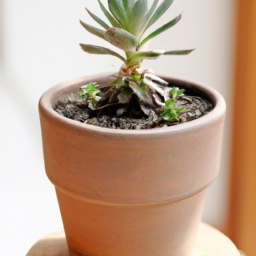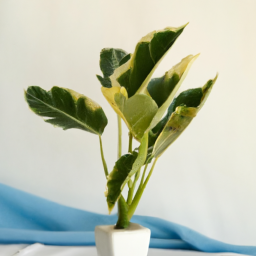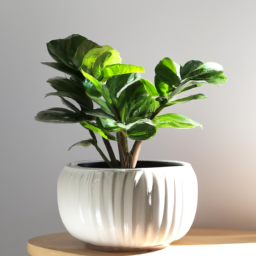
Are you looking to bring a touch of nature into your home? Indoor plants can be the perfect solution! Not only do they add a vibrant pop of green to any space, but they also provide numerous health benefits. From purifying the air to boosting mood and productivity, indoor plants have become a popular choice for homeowners and plant enthusiasts alike. In this blog post, we will explore the vast world of indoor plants variety, discussing different types of plants that thrive indoors and how to care for them. Whether you have a green thumb or are just starting your plant journey, this guide will help you choose the perfect indoor plants to transform your living space into a lush and inviting oasis. So, let’s dive in and discover the stunning array of indoor plants variety that awaits!
Benefits of Indoor Plants Variety
Introduction
Indoor plants not only add beauty to our living spaces but also offer numerous benefits for our physical and mental well-being. Having a variety of indoor plants can enhance these benefits even further. In this article, we will explore the advantages of incorporating different types of indoor plants into your home or office environment. So, let’s dive in and discover the wonders of indoor plants variety!
Improved Air Quality
One of the primary benefits of having a diverse range of indoor plants is their ability to purify the air we breathe. Each plant species has unique qualities that help filter out harmful pollutants and release oxygen. By having a variety of indoor plants, you can create a healthier and fresher indoor environment.
For instance, the Snake Plant (Sansevieria) is known for its ability to remove toxins like formaldehyde and benzene from the air. The Spider Plant (Chlorophytum comosum) is excellent at absorbing carbon monoxide and other harmful substances. By combining these plants and others like the Peace Lily (Spathiphyllum) and Aloe Vera, you can create a powerful air-purifying system.
Furthermore, indoor plants also help regulate humidity levels, reducing the risk of respiratory issues and dry skin. They act as natural humidifiers, especially during the drier winter months when central heating systems tend to dry out the air.
Enhanced Mental Well-being
Indoor plants have a remarkable impact on our mental well-being. Their presence can reduce stress, anxiety, and even boost our mood. By incorporating a variety of indoor plants, you can create a more diverse and visually stimulating environment, which promotes relaxation and calmness.
Studies have shown that being surrounded by nature, even indoors, can improve concentration and productivity. The different colors, shapes, and textures of various indoor plants create a visually appealing setting, making our living and working spaces more enjoyable.
Moreover, taking care of indoor plants can be a therapeutic activity. It allows us to connect with nature, fostering a sense of responsibility and providing a soothing effect. Watching plants grow and thrive can be immensely satisfying and rewarding, contributing to our overall happiness and well-being.
Improved Cognitive Function
Having a variety of indoor plants can also have positive effects on our cognitive function. Research has shown that being in the presence of plants can improve memory, attention span, and overall cognitive performance.
Plants release chemicals called volatile organic compounds (VOCs) that can enhance brain function. For example, the scent of lavender has been found to improve concentration and reduce stress. By incorporating lavender plants along with other varieties such as Rosemary, Eucalyptus, and Mint, you can create a stimulating and mentally invigorating environment.
Furthermore, the increased oxygen levels resulting from indoor plants’ photosynthesis process can improve brain function and memory retention. Having a mix of plants like the Boston Fern (Nephrolepis exaltata), English Ivy (Hedera helix), and Areca Palm (Dypsis lutescens) can significantly enhance cognitive abilities.
Conclusion
Incorporating a variety of indoor plants into your living or working environment brings forth a multitude of benefits. From improved air quality to enhanced mental well-being and cognitive function, indoor plants have the power to transform our spaces into healthier, more vibrant, and inspiring places to be.
So, why not start exploring the world of indoor plants variety today? Experiment with different species, mix and match colors and textures, and create your own personal indoor oasis. Your mind, body, and soul will thank you for it!

Popular Indoor Plants Variety for Beginners
Indoor plants not only add beauty and freshness to your living space but also have numerous health benefits. They purify the air, reduce stress, and improve overall well-being. If you are a beginner looking to start your indoor plant collection, here are some popular varieties that are easy to care for and perfect for beginners.
1. Snake Plant
The Snake Plant, also known as Sansevieria, is a popular choice for beginners due to its low maintenance nature. It has long, stiff leaves that are green with yellow edges, resembling a snake’s skin. This plant can thrive in both bright and low light conditions, making it suitable for any room in your home.
Snake Plants are known for their air-purifying abilities, as they absorb toxins and release oxygen at night. They require minimal watering and can survive in dry environments, making them perfect for forgetful or busy plant owners.
To care for a Snake Plant, place it in well-draining soil and water it sparingly, allowing the soil to dry out between waterings. Avoid overwatering, as it can lead to root rot. This plant can tolerate a wide range of temperatures and is generally pest-resistant.
2. Spider Plant
The Spider Plant, scientifically known as Chlorophytum comosum, is another popular choice for beginners. It has long, arching leaves with green and white stripes, resembling spider legs. This plant is known for its ability to produce baby spider plants, which can be easily propagated and shared with friends.
Spider Plants thrive in bright, indirect light but can tolerate lower light conditions as well. They prefer well-draining soil and should be watered regularly, allowing the top inch of soil to dry out between waterings. Overwatering can cause root rot, so it’s important to maintain a proper watering schedule.
These plants are excellent air purifiers and can remove harmful toxins from the air, such as formaldehyde and xylene. They are also non-toxic to pets, making them a safe choice for households with furry friends.
3. Pothos
Pothos, also known as Devil’s Ivy, is a popular trailing plant that is perfect for beginners. It has heart-shaped leaves that come in various shades of green, making it a visually appealing addition to any room. Pothos is known for its ability to thrive in a wide range of light conditions, from low to bright indirect light.
This plant is easy to care for and can tolerate periods of neglect. It prefers well-draining soil and should be watered when the top inch of soil feels dry. Pothos can also be grown in water, making it a versatile option for those who prefer hydroponic gardening.
Pothos is known for its air-purifying qualities and can remove toxins like formaldehyde and benzene from the air. It is also a great choice for hanging baskets or as a trailing plant on shelves or bookcases.
These are just a few popular indoor plant varieties for beginners. Each plant has its own unique characteristics and care requirements, so it’s important to research and understand the specific needs of the plants you choose. Remember to observe your plants regularly and adjust their care accordingly. With proper care and attention, your indoor plant collection will flourish and bring joy to your living space.

Tips for Caring for Indoor Plants Variety
Indoor plants are a wonderful addition to any home or office space. They not only add beauty and color to the environment but also provide numerous health benefits. However, caring for indoor plants can sometimes be a bit challenging, especially if you are new to gardening. In this article, we will provide you with some valuable tips on how to care for a variety of indoor plants, ensuring they thrive and bring joy to your space.
Understanding Different Indoor Plants
Before diving into the care tips, it’s essential to understand that different indoor plants have varying needs. Some plants prefer bright, indirect light, while others thrive in low light conditions. Similarly, the watering requirements, humidity preferences, and temperature tolerance can vary significantly between plant species. Therefore, it’s crucial to familiarize yourself with the specific needs of the plants you have or plan to acquire.
When selecting indoor plants, consider factors such as the available space, lighting conditions, and the amount of time you can dedicate to their care. Some popular indoor plants include the Snake Plant, Pothos, Spider Plant, Peace Lily, and ZZ Plant. Each of these plants has its own unique characteristics and care requirements.
Once you have identified the indoor plants you want to care for, follow these tips to ensure their well-being:
1. Provide Adequate Lighting
Light is one of the most crucial factors for indoor plant growth. Most indoor plants thrive in bright, indirect light. However, it’s important to note that not all plants require the same amount of light. Some plants, like succulents and cacti, prefer direct sunlight, while others can tolerate low light conditions.
Place your plants near windows or in areas where they can receive sufficient light. If your space lacks natural light, you can use artificial grow lights specifically designed for indoor plants. These lights provide the necessary spectrum and intensity to support plant growth.
Monitor your plants regularly to ensure they are not receiving too much or too little light. Signs of inadequate lighting include pale or elongated stems, small leaves, and a lack of growth. On the other hand, if your plants are getting too much light, you may notice scorched or yellowing leaves.
2. Watering Indoor Plants
Watering is another critical aspect of indoor plant care. The frequency and amount of water required depend on various factors, including the plant species, pot size, humidity levels, and environmental conditions.
Before watering your plants, check the moisture level of the soil. Stick your finger about an inch deep into the soil; if it feels dry, it’s time to water. However, if it’s still moist, hold off on watering to avoid overwatering, which can lead to root rot and other issues.
When watering, ensure that the water reaches the roots and drains out of the pot’s drainage holes. It’s important not to let your plants sit in standing water, as it can cause root rot. Additionally, some plants, like succulents, prefer drier soil and should be watered less frequently.
Remember that different plants have different water requirements, so it’s essential to research the specific needs of each plant you own.
3. Maintaining Proper Humidity and Temperature
Indoor plants thrive in environments with moderate humidity levels. However, the ideal humidity range can vary depending on the plant species. Some plants, such as ferns and orchids, prefer higher humidity, while others, like cacti, are more tolerant of drier conditions.
To increase humidity around your plants, you can use a humidifier or place a tray filled with water near them. Misting the leaves with water also helps raise humidity levels. On the other hand, if the air is too humid, you can improve ventilation or use a dehumidifier to prevent fungal diseases.
In terms of temperature, most indoor plants prefer temperatures between 60°F (15°C) and 75°F (24°C). However, some plants, like succulents, can tolerate higher temperatures, while others, such as tropical plants, may require warmer conditions.
Avoid placing your plants near drafts, heating vents, or air conditioning units as sudden temperature changes can stress them. Additionally, keep them away from cold windows during winter, as the temperature drop can harm the plants.
By maintaining the appropriate humidity and temperature levels, you can create a favorable environment for your indoor plants to thrive.
Remember, each plant is unique, and it’s crucial to research and understand the specific care requirements of the indoor plants you own. With proper lighting, watering, humidity, and temperature control, your indoor plants will flourish and bring life to your space. Happy gardening!
Let’s recap
Indoor plants are a fantastic way to bring life and vibrancy into any space. Whether you have a green thumb or struggle to keep plants alive, there is a wide variety of indoor plants to suit every level of expertise. From low-maintenance succulents to lush, tropical foliage, the options are endless.
One popular choice for indoor plants is the snake plant, also known as the mother-in-law’s tongue. This hardy plant is perfect for beginners as it can tolerate low light conditions and infrequent watering. Its long, sword-shaped leaves add a touch of elegance to any room. Another great option is the pothos plant, which is known for its trailing vines and heart-shaped leaves. Pothos are incredibly resilient and can thrive in a variety of light conditions, making them an ideal choice for any space.
For those looking to add a splash of color to their indoor oasis, the African violet is a fantastic choice. These delicate flowers come in a range of hues, from soft pastels to vibrant purples and pinks. They require a bit more care, with specific watering and light needs, but the payoff is well worth it. If you’re looking for a statement plant, consider the fiddle leaf fig. With its large, glossy leaves and tall stature, this plant adds a dramatic touch to any room. However, it does require a bit more attention, with regular watering and bright, indirect light.
No matter your skill level or design preference, there is an indoor plant variety that is perfect for you. From low-maintenance options to those that require a bit more care, indoor plants are a wonderful way to bring nature indoors and create a peaceful, inviting atmosphere. So go ahead, explore the world of indoor plants and find the perfect green companion for your space!
Here are some FAQs you’d be interested in:
Q1: What are some popular varieties of indoor plants?
A1: There are numerous popular varieties of indoor plants to choose from. Some common options include the Snake Plant, Spider Plant, Pothos, Peace Lily, and ZZ Plant. These plants are known for their ability to thrive indoors and require minimal maintenance.
Q2: Which indoor plants are suitable for low-light conditions?
A2: If you have low-light conditions in your home or office, there are still plenty of indoor plants that can thrive. Some excellent choices for low-light environments include the Cast Iron Plant, Chinese Evergreen, Dracaena, and the Snake Plant. These plants are known for their ability to tolerate and even thrive in low-light situations.
Q3: What are some indoor plants that are pet-friendly?
A3: If you have furry friends at home, it’s important to choose indoor plants that are safe for them. Some pet-friendly indoor plants include the Boston Fern, Areca Palm, Money Tree, and the Parlor Palm. These plants are non-toxic to cats and dogs, providing you with peace of mind.
Q4: How often should I water indoor plants?
A4: The watering frequency for indoor plants can vary depending on several factors, such as the type of plant, the size of the pot, and the environmental conditions. As a general guideline, most indoor plants thrive when the top inch of soil feels dry. It’s important to avoid overwatering, as it can lead to root rot. Regularly check the moisture level of the soil and adjust your watering schedule accordingly.
Q5: What are some easy-to-care-for indoor plants for beginners?
A5: If you’re new to indoor gardening, starting with easy-to-care-for plants is a great idea. Some beginner-friendly options include the Snake Plant, Pothos, Spider Plant, and the Peace Lily. These plants are known for their resilience and ability to withstand occasional neglect. They can tolerate different light conditions and are forgiving when it comes to watering mistakes.
Dr. Olivia Green is a botanist with over two decades of experience in indoor plant cultivation. She holds a Ph.D. in Plant Biology and has dedicated her career to researching plant behavior in controlled environments. Dr. Green is passionate about helping plant enthusiasts master the art of indoor gardening through her extensive knowledge and practical insights.


